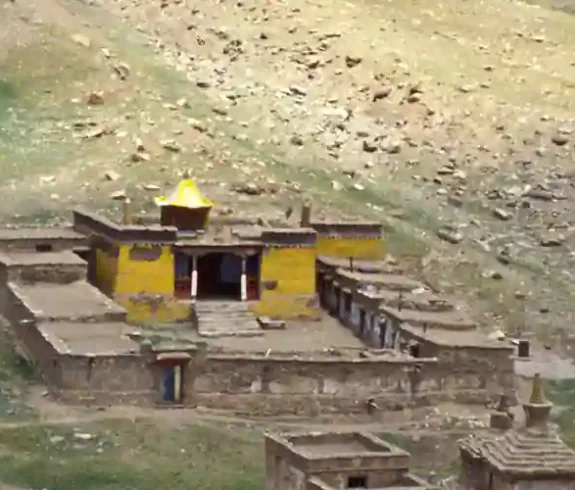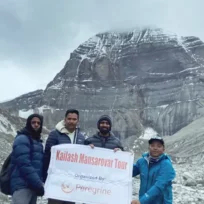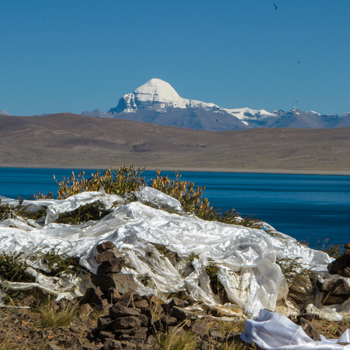The Kailash Inner Kora beckons adventurous souls on a challenging and profoundly spiritual trek encircling the sacred Mount Kailash in Tibet. This mere 32-kilometer route presents a more rugged and demanding alternative to the 52-kilometer Outer Kora.
The Inner Kora is a transformative pilgrimage for those yearning for profound spiritual growth. Pilgrims believe that completing this tour can ignite spiritual awakening, cleanse the soul, and break free from the cycle of rebirth. This trek is a pathway to connect with the divine energy emanating from Mount Kailash, revered as the dwelling of Lord Shiva in Hinduism, Demchog in Tibetan Buddhism, and the spiritual heart of the world in many traditions.
Exploring the Inner Kora’s Sacred Path: A Spiritual Adventure
The Kailash Inner Kora trail leads pilgrims through a dramatic landscape of soaring cliffs, icy valleys, and hallowed sites. Typically, the tour begins in Darchen, a quaint village near Mount Kailash. Here’s a glimpse of the key sites you’ll encounter on the Inner Kora:
- Darchen: Your adventure starts here, in this base camp, where you can adjust to the high altitude and prepare for the trek.
- Serlung Monastery: This stunning monastery offers breathtaking vistas of Mount Kailash.
- Charansparsh: You can physically touch the holy mountain at this sacred site.
- Nandi Parvat: This majestic peak faces Mount Kailash and is said to be the dwelling of Nandi, Lord Shiva’s loyal bull.
- Gauri Kund: Legend has it that Goddess Parvati bathed in this holy lake.

Geographic and Spiritual Odyssey
Tour the heart of Tibet’s sacred landscape and discover the path less traveled on the Kailash Inner Kora. This demanding pilgrimage, one of the spiritual sites of Kailash, unveils rugged beauty and spiritual depth, distinguishing it from the famous Outer Kora.
Walking the Inner Kora Path: A Pilgrimage through Sacred Ground
The Kailash Inner Kora trail winds through a breathtaking landscape, showcasing hidden wonders and challenging physical limits. Begin your tour in Darchen, and let the trail guide you on a clockwise circuit around the majestic Mount Kailash. Key Landmarks and Encounters:
- Serlung Monastery: Ascend to this peaceful monastery and absorb the tranquil atmosphere while taking in breathtaking views of Mount Kailash.
- Charansparsh: Pilgrims touch the sacred rock face at Charan Sparsh, creating a profound connection with the holy mountain.
- Nandi Parvat: Gaze across the majestic Nandi Parvat, a neighboring peak believed to be the dwelling of Nandi, Lord Shiva’s divine bull.
- Gauri Kund: Pilgrims pause at the high-altitude Gauri Kund, a lake revered as the bathing spot of Goddess Parvati.
- Atmalingam: Witness the mystical Atmalingam, a naturally formed ice lingam believed to embody Lord Shiva’s divine energy.
Conquering the Inner Kora’s Challenges: A Trial of Strength and Spirit
The pilgrimage to Mount Kailash via the Inner Kora is a test of resilience. The terrain is more rugged and challenging than the Outer Kora.
- High Altitude: Be prepared for the high altitude, with the highest point soaring to around 5,600 meters (18,373 feet). Proper acclimatization is crucial to avoid altitude sickness.
- Steep and Rocky Trails: The path presents steep climbs and descents over rocky and uneven terrain. Trekking poles and sturdy hiking boots are your allies.
- Unpredictable Weather: Nature can be unpredictable at high altitudes. Be ready for sudden changes in weather, including snowstorms and rain, even during warmer months. Layering your clothing is vital to staying comfortable.
- Remote Wilderness: The Kailash Inner Kora is more isolated than the Outer Kora, with fewer amenities and limited access to emergency services. Preparedness is essential.
- Physical Demands: The trek requires good physical fitness and stamina. To prepare your body for the challenge, train in advance with hikes at progressively higher altitudes.
Pilgrimage of Profound Spiritual Meaning
The Kailash Inner Kora is not just a trek; it’s a profound spiritual experience that holds deep meaning for followers of various faiths. This challenging tour around Mount Kailash in Tibet resonates with the spiritual beliefs of Buddhists, Hindus, Jains, and those who practice the ancient Bon religion. Each group finds unique significance in this rugged landscape and its sacred sites.
Religious Significance of the Inner Kora
The Inner Kora route is more than a physical test; it symbolizes personal growth and spiritual transformation. Many believe completing this pilgrimage leads to enlightenment, purification of the soul, and, ultimately, liberation from the cycle of rebirth.
- Hinduism: Hindus revere Mount Kailash as the sacred dwelling of Lord Shiva, the powerful deity of destruction and transformation. The Mount Kailash pilgrimage via the Inner Kora offers a path to spiritual liberation and a deeper connection with Shiva’s divine energy.
- Buddhism: Tibetan Buddhists view Mount Kailash as the home of Demchog, a wrathful deity embodying compassion and wisdom. The Kailash Inner Kora signifies enlightenment, transcending suffering, and achieving nirvana.
- Jainism: For Jains, the region near Mount Kailash, especially Ashtapad, is essential. It’s believed to be where Rishabhadeva, their first Tirthankara, attained enlightenment (moksha). The Kailash Inner Kora pilgrimage holds deep meaning and spiritual significance for Jains.
- Bon: Preceding Buddhism in Tibet, the Bon religion considers Mount Kailash, the “nine-story Swastika Mountain,” a potent source of spiritual energy. The Inner Kora is a sacred ritual for Bon practitioners to connect with their ancient tradition.
Sacred Sites Along the Inner Kora: Echoes of the Divine
Every step of the Inner Kora route leads you past spiritually charged locations, each steeped in history and mythology.
- Serlung Monastery: This tranquil monastery holds a special place in Tibetan Buddhism. Pilgrims often receive blessings from the monks residing here and find a serene space for prayer and reflection.
- Charansparsh: At this sacred rock face, pilgrims physically touch the holy mountain, believing this act purifies their souls and brings them closer to enlightenment.
- Nandi Parvat: This majestic peak, believed to be the dwelling of Nandi, Lord Shiva’s divine bull, symbolizes unwavering devotion and faith.
- Gauri Kund: Revered as the bathing place of Goddess Parvati, this high-altitude lake represents purity, fertility, and feminine divine energy. Pilgrims often perform rituals and offer prayers here.
- Atmalingam: This naturally formed ice lingam, a manifestation of Lord Shiva, draws devotees seeking blessings and spiritual renewal. It’s a powerful symbol of divine energy.
- Saptarishi Cave: Associated with seven legendary sages who achieved enlightenment at Mount Kailash, this cave serves as a reminder of the path to wisdom and spiritual awakening.
- Ashtapad: For Jains, this site near Mount Kailash holds immense significance. It marks the place where Rishabhadeva attained liberation (moksha). Pilgrims meditate and perform rituals here, seeking to follow in his footsteps.

Essential Tips for a Successful Pilgrimage
The Kailash Inner Kora, a challenging yet spiritually rewarding trek around Tibet’s sacred Mount Kailash, demands thorough preparation. Plan meticulously to ensure a safe and fulfilling experience on this high-altitude pilgrimage.
Physical Preparation: Train Your Body
This trek challenges you physically with steep climbs, high altitudes, and rugged trails. Get in shape to tackle these obstacles:
- Prioritize Cardiovascular Fitness: Regular aerobic exercises like running, hiking, or cycling boost stamina. Strive for at least 30 minutes of moderate exercise on most days of the week.
- Strengthen Your Muscles: Focus on building strength in your legs, core, and back. Incorporate squats, lunges, planks, and rows into your workout routine to prepare your body for the trek’s demands.
- Acclimatize to Altitude: Spend a few days before the trek in Darchen (elevation 4,575 meters/15,010 feet) or a similar high-altitude environment. Allowing your body to adapt to the thinner air will reduce the risk of altitude sickness.
Mental Preparation: Strengthen Your Mind
The Kailash Inner Kora tests not only your body but also your mind. Prepare yourself mentally for the challenges ahead:
- Educate Yourself: Learn about the trek’s difficulties, the terrain, and the cultural context. Understanding what to expect will increase your confidence and help you set realistic expectations.
- Maintain a Positive Attitude: Approach the pilgrimage with a positive mindset and focus on your reasons for undertaking it. A positive outlook helps you overcome obstacles and appreciate the experience.
- Respect the Culture: Learn about Tibetan customs and traditions to demonstrate respect for the local people and their environment.
- Embrace Spiritual Practices: If spirituality is part of your life, engage in meditation, prayer, or other practices that resonate with you. This experience will deepen your connection to the sacred nature of the pilgrimage.
Permits and Logistics: Organize Your Trip
Before starting your Mount Kailash pilgrimage, take care of the necessary permits and logistics:
- Obtain a Tibet Travel Permit: This is mandatory for all foreign travelers to Tibet. Secure it through a registered tour agency.
- Secure an Alien’s Travel Permit: You need this permit to access restricted areas like Mount Kailash.
- Hire a Local Guide: Due to its challenging terrain and cultural considerations, a local guide is mandatory for the Inner Kora. They provide invaluable knowledge about the region’s history, culture, and spiritual traditions.
- Purchase Travel Insurance: Comprehensive travel insurance covering high-altitude trekking and emergency evacuation is crucial.
Optimal Timing for the Kailash Inner Kora
The best time to trek the Kailash Inner Kora is from late spring to early autumn (May to October). Weather conditions are generally stable during this period, and the trails are clear of snow. Avoid the monsoon season (July-August), as heavy rains can make the trek dangerous. Additional trekking tips:
- Pack Light: Bring only essential gear to minimize your load.
- Maintain Hydration: Hydrate regularly throughout the day to combat dehydration and lessen the likelihood of altitude sickness.
- Ascend Gradually: Adapt to the increasing altitude by ascending slowly and incorporating rest days into your itinerary, especially at higher elevations.
- Dress in Layers: Pack layered clothing to adapt quickly to the trail’s unpredictable weather changes.
- Listen to Your Body: If you experience any symptoms of altitude sickness, like headaches, nausea, or dizziness, descend to a lower altitude immediately.
Planning Your Inner Kora Adventure: A Step-by-Step Guide
The Kailash Inner Kora is a remarkable spiritual trek, shorter yet more demanding than its well-known counterpart, the Outer Kora. To make the most of this pilgrimage, let’s map out a typical itinerary, discuss the duration, and explore your options for lodging and sustenance.
Charting Your Course: A Typical Inner Kora Itinerary
The Inner Kora trail encircles the sacred Mount Kailash clockwise, typically beginning and ending in the bustling town of Darchen. Most pilgrims complete the circuit in two days, though experienced trekkers may opt for a single, strenuous day.
Day-1
- Set off from Darchen: Your tour begins in Darchen, the pilgrimage’s base camp. You can hike or hire a horse for the first 4.5 kilometers to Serlung Monastery.
- Discover Serlung Monastery: Explore this serene monastery and bask in the awe-inspiring views of Mount Kailash.
- Ascend to Camp: Continue your climb towards the first campsite, nestled at the foot of Mount Kailash, approximately 8 kilometers from Serlung Monastery.
Day-2
- Conquer Dolma La Pass: The trek’s most challenging leg takes you to Dolma La Pass (5,630 meters), the highest point of the Inner Kora. Soak in the breathtaking panoramic views of the surrounding mountains and glaciers.
- Descend to Darchen: Begin your gradual descent back to Darchen, passing by Gauri Kund and other sacred sites along the way.
- Complete Your Pilgrimage: Celebrate your accomplishment as you reach Darchen, completing the Kailash Inner Kora.
Duration: How Long Will Your Trek Take?
- One-Day Challenge: Experienced and acclimatized trekkers may complete the Inner Kora in a single, demanding day.
- Two-day tour: Most pilgrims prefer the two-day itinerary, allowing for proper acclimatization and a more leisurely pace to appreciate the spiritual significance of each site.
Where to Stay and What to Eat: Accommodation and Sustenance
- Camping: Many pilgrims choose to camp at designated campsites near Serlung Monastery and the base of Mount Kailash. Bring your gear or rent it in Darchen. Choose based on your comfort and convenience, ensuring you have everything needed for your tour.
- Guesthouses: Darchen offers basic guesthouses with simple rooms and shared facilities, a convenient option for the night before and after your trek.
- Food Options: While some tea houses along the route provide basic meals and drinks, we recommend carrying your food and snacks. Stock up on supplies in Darchen before you start. Remember, water sources are limited, so bring enough for the trek.

Overcoming Challenges and Ensuring Safety on Your Sacred Trek
The Kailash Inner Kora is a spiritual pilgrimage that pushes your physical and mental boundaries. While the rewards are profound, understanding and preparing for the inherent challenges is critical to a safe and successful experience when preparing for Kailash Inner Kora.
Altitude and Terrain: Your Physical Trials
The Mount Kailash pilgrimage via the Inner Kora presents two formidable physical challenges: high altitude and demanding terrain.
- Conquer Altitude Sickness: The high altitude of the Inner Kora, peaking at Dolma La Pass (5,630 meters/18,373 feet), can trigger altitude sickness. Watch for symptoms like headaches, nausea, fatigue, and shortness of breath. Acclimatize gradually, ascend slowly, stay hydrated, and consult your doctor about altitude sickness medication.
- Navigate Rugged Terrain: Unlike the Outer Kora, the Inner Kora trail is less developed, marked by steep climbs, rocky paths, and potential snow or ice. Prepare by wearing sturdy hiking boots, using trekking poles for stability, and packing for unpredictable weather.
Prioritizing Your Health on the Trek
Altitude sickness isn’t the only concern on this pilgrimage. Other health issues can arise:
- Combat Dehydration: The dry air and physical exertion can dehydrate you quickly. Drink plenty of fluids and carry water purification tablets or a filter.
- Protect Yourself from the Sun: High altitudes intensify the sun’s rays. Shield yourself with a hat, sunglasses, and sunscreen with a high SPF.
- Stay Warm: Temperatures can plummet, especially at night. Pack warm layers of clothing and a quality sleeping bag to prevent hypothermia.
- Prevent Blisters: Ill-fitting footwear can cause painful blisters. Ensure your hiking boots are well-worn before you set off, and pack supplies to treat any potential blisters.
The Kailash Inner Kora: Tread Lightly and Protect This Sacred Landscape
The Kailash Inner Kora is a spiritual tour and an adventure through a delicate ecosystem. As a responsible trekker, you hold the power to preserve the pristine beauty of this sacred land. Explore some essential environmental considerations and eco-friendly trekking practices to ensure a sustainable pilgrimage.
Why Protecting the Environment Matters on the Inner Kora
The Kailash Inner Kora trail weaves through a fragile, high-altitude environment, home to unique plant and animal life. As a visitor, your actions can significantly affect this sensitive region. Embrace eco-friendly trekking for these reasons:
- Preserve the Sacred: Mount Kailash is deeply spiritually significant to many faiths. Protect its purity by maintaining the environment’s natural state.
- Safeguard Biodiversity: The region thrives on diverse plant and animal life, many of which are uniquely adapted to harsh conditions. Your mindful actions help ensure their survival.
- Minimize Pollution: Trash and waste disrupt the natural ecosystem and harm wildlife. Let’s keep this landscape pristine.
- Reduce Your Footprint: Sustainable practices help lessen the environmental impact of your travels and trek.
Eco-Friendly Trekking Tips for the Inner Kora
Leave No Trace
- Pack It All Out: Carry all trash and waste, including food scraps and toilet paper, back with you.
- Stick to the Trail: Stay on designated paths to avoid damaging vegetation and contributing to soil erosion.
- Mind Your Campfires: Use designated fire rings and gather only dead wood if fires are allowed.
- Observe, Don’t Disturb: Respect the natural habitat by not disturbing rocks, plants, or wildlife. Keep a safe distance and appreciate them from afar.
Conserve Water
- Use Water Sparingly: Be mindful of your water usage when drinking, cooking, and cleaning.
- Protect Water Sources: Avoid washing dishes or clothes directly in streams or lakes. If using soap, choose biodegradable options.
- Carry a Reusable Bottle: To reduce waste, refill your bottle at designated sources or use a water filter/purifier.
Show Respect for Wildlife
- From a Distance: Observe wildlife from afar, respecting their natural habitat and behaviors. Avoid feeding or approaching animals, as this can disrupt their instincts and create dependence on humans.
- Protect Their Homes: Avoid disturbing nests, dens, or caves.
- Be Mindful of Noise: Loud noises stress wildlife and disrupt the serene atmosphere of the region.
Choose Sustainable Options
- Support Local Businesses: Opt for locally owned guesthouses and restaurants to contribute to the local economy.
- Minimize Plastic: Bring a reusable shopping bag and avoid single-use plastics.
- Travel Responsibly: Choose transportation options that minimize carbon emissions.

Experiencing Tibetan Culture on the Inner Kora: A Guide to Respectful Engagement
The Kailash Inner Kora trail winds through Tibetan villages, monasteries, and sacred sites, revealing the vibrant tapestry of Tibetan culture and heritage. Engaging respectfully with local communities will enhance your Mount Kailash pilgrimage and contribute to sustainable tourism.
Embrace Tibetan Culture Along the Inner Kora
As you trek the Inner Kora, embrace the vibrant Tibetan culture you encounter:
- Visit Serlung Monastery: Interact with the monks, witness their daily rituals, and gain insights into Tibetan Buddhism.
- Meet Nomadic Herders: You may encounter nomadic herders tending their yaks and sheep. Respect their way of life and always ask permission before taking photos.
- Appreciate Prayer Flags: Observe the colorful prayer flags adorning the landscape. These flags carry mantras and blessings, so treat them with reverence.
- Honor Mani Stones: Along the trail, you’ll find these carved stones inscribed with prayers and mantras. Walk clockwise around them to show respect.
- Respect Sky Burial Sites: You might encounter sky burial platforms, a traditional Tibetan funerary practice. Observe from afar and refrain from photographing the site, respecting its solemnity.
Respectful Interactions: Guidelines for Cultural Sensitivity
Your Mount Kailash pilgrimage is a tour of another culture. Nurture respectful relationships and positive interactions with the local Tibetan communities by embracing these guidelines:
- Learn Basic Tibetan Phrases: Extend a warm “Tashi Delek” (hello) and express gratitude with “Thuk je che” (thank you). These simple phrases go a long way.
- Dress Modestly: Honor local customs by wearing clothing that is not revealing, particularly when visiting monasteries.
- Seek Permission Before Photographing: Always ask before taking photos of people or their belongings. Consider offering a small donation as a token of appreciation.
- Support Local Businesses: Purchase souvenirs and supplies from local vendors to support the community’s livelihood.
- Practice Patience and Understanding. Remember, you’re a guest in their land: approach language barriers and cultural differences with patience and an open mind.
- Offer Help: If you encounter someone needing assistance, extend a helping hand.
- Leave No Trace: Respect the environment by properly disposing of any trash.
- Research Cultural Norms: Familiarize yourself with Tibetan etiquette and cultural norms before the trek.







